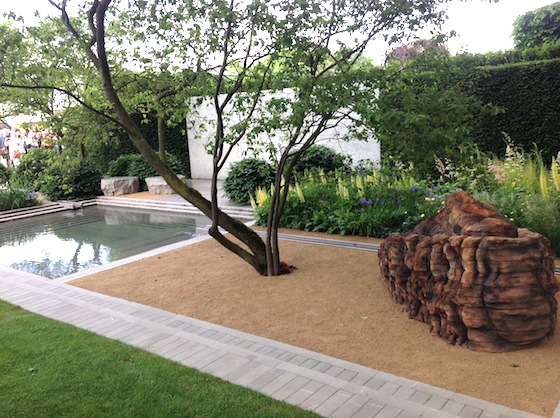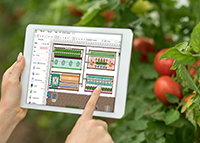I had the fortune of visiting the RHS Chelsea Flower Show in England—which is over one hundred years old—and brought back photos for your viewing pleasure.
On this page are just three of the large gardens from this show (in 2014 though I think the designs are timeless). Which do you like best?
Overall, I would say that I was surprised by the formality of the garden design—though most of the gardens seemed to soften the formality with soft “naturalistic” plantings to give a sense of balance.
1. “The Laurent-Perrier Garden”



This quietly elegant garden (which won “Best Show Garden”) features a modern rectangular pool, smooth concrete walls, terracing, and a geometric layout.
These structural elements contrast with the soft pastel shades of the flowers, the cedar sculpture, the shadows cast by the trees, and the moving leaves reflected in the water. I love the light yellow lupines and the fresh lemon-greens with hints of light purple with iris and phlox.
2. “The Telegraph Garden”



Inspired by Italy, this garden seems more traditional but has flashes of American modernism. Notice the formal rectangular lawn with shaped topiaries on the corners, the limestone wall, and the hedges. I love the lemon trees in containers and the lime trees that are clipped to create a canopy.
All of these geometric shapes are softened by beds of green grasses and herbaceous perennials in colors of the sky and sea—such as cornflower, blue borage, and blue iris. The plantings around the lawn are loose and graceful. For me, this garden is quite inviting—and I wished that I could have relaxed in it!
3. “The M&G Paradise Garden”


The third garden is a modern take on the ancient Paradise gardens—which were desert refuges thousands of years ago. Key features of a Paradise garden are shade, water, and food.
Shade is provided by four trees around the garden, which represent earth, water, air, and fire. Water flows from a tall, octagonal fountain, symbolizing the garden of Eden. Fruit is represented by grapevines and wild strawberries. Carved into the large stone wall is the Tree of Life, symbolizing the roots of gardening. The gravel is a metaphor for the desert—and planted with perennials.
More to Come
.jpg) There were so many more gardens—inspired by water conservation, the night sky, memory loss and reflection, the centenary of World War I, the recovery of injured soldiers, and more.
There were so many more gardens—inspired by water conservation, the night sky, memory loss and reflection, the centenary of World War I, the recovery of injured soldiers, and more.
I’ve photographed one of my all-time favorites, the Night Sky Garden, here.
There were also thought-provoking exhibitions. One was called the “Butterfly Effect”—about butterflies and the crucial role that they play as pollinators. Another, called “Petals and Pests,” was about using petal color and flower barriers when planting crops to reduce pests and minimize insecticide use.
So, which of the three gardens featured here is your favorite? Please vote below!












.jpg) There were so many more gardens—inspired by water conservation, the night sky, memory loss and reflection, the centenary of World War I, the recovery of injured soldiers, and more.
There were so many more gardens—inspired by water conservation, the night sky, memory loss and reflection, the centenary of World War I, the recovery of injured soldiers, and more.







